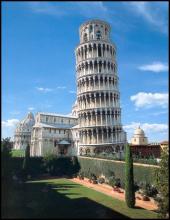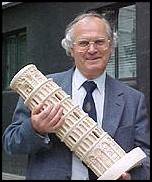'Rescuing the Leaning Tower of Pisa' by Professor John Burland

Seminar overview:
Imagine a tower, founded on very soft material and slowly inclining to the point at which it is about to fall over. Worse still, the masonry is so fragile that it could explode at any time. This is a reasonable description of the state of the Leaning Tower of Pisa at the time that the Italian Prime Minister set up a Commission to stabilise it in early 1990. After years of study of its history, computer modelling and field trials, stabilisation measures started in February 1999. Using a novel method of soil extraction from beneath the high side of the foundation the Tower was gently brought back to its inclination in 1838. Recent measurements show that the stabilisation methods have been successful. Professor John Burland will share some of the challenges, frustrations and more worrying moments of participating in such a high profile and difficult engineering project.
Short biography:

Professor John Burland studied Civil Engineering at the University of the Witwatersrand, in South Africa before returning to England in 1961. After studying for his PhD at Cambridge University, he joined the Building Research Station in 1966. In 1980 he was appointed to the Chair of Soil Mechanics at Imperial College, where he is now Emeritus Professor.
In addition to being very active in teaching (which he loves) and research, he has been responsible for many large projects such as the underground car park at the Palace of Westminster and the foundations of the Queen Elizabeth II Conference Centre. He specialises in problems relating to the interaction between the ground and masonry buildings. He was London Underground's expert witness for the Parliamentary Select Committees on the Jubilee Line Extension and has advised on many geotechnical aspects of that project, including ensuring the stability of the Big Ben Clock Tower. He was a member of the international board of consultants advising on the stabilisation of the Metropolitan Cathedral of Mexico City and was a member of the Italian Prime Minister's Commission for stabilising the Leaning Tower of Pisa.
He has received many prestigious awards including the Kelvin Gold Medal for Outstanding contributions to Engineering, the Harry Seed Memorial Medal of the ASCE and the Gold Medals of the Institution of Structural Engineers, the Institution of Civil Engineers and the World Federation of Engineering Organisations. He has been awarded four Honorary Doctorates and he is a Fellow of both the Royal Academy of Engineering and the Royal Society. In 2002 he was President of the Engineering Section of the British Association and he was Vice President (Engineering) of the Institution of Civil Engineers, London from 2002 to 2005.
Directions to the Junior Parlour, Trinity College
The main entrance (Great Gate) of Trinity College is found on Trinity Street, close to the end of All Saint’s Passage. To reach the Junior Parlour, you do not enter Trinity College through the Great Gate. The entrance to Whewell's Court is directly opposite the Great Gate of Trinity College, next to the old post office and Heffer's bookshop. When you enter into Whewell's Court, turn right immediately after the first arch‐way. Climb the open‐air stairs until you are just short of the top. Turn right into T staircase. The Junior Parlour is at the end of the passageway through the door.
